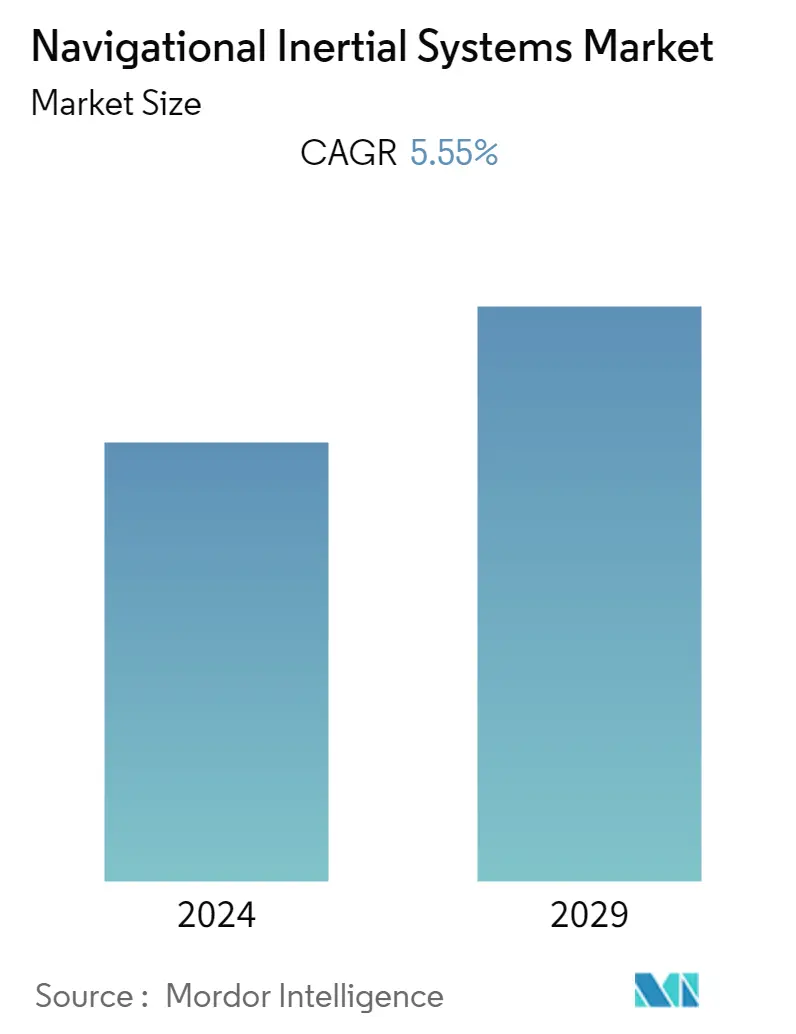Market Size of Navigational Inertial Systems Industry

| Study Period | 2019 - 2029 |
| Base Year For Estimation | 2023 |
| CAGR | 5.55 % |
| Fastest Growing Market | Asia-Pacific |
| Largest Market | North America |
| Market Concentration | Medium |
Major Players.webp)
*Disclaimer: Major Players sorted in no particular order |
Need a report that reflects how COVID-19 has impacted this market and its growth?
Navigational Inertial Systems Market Analysis
The inertial navigation system market is expected to grow at a CAGR of 5.55% over the forecast period (2021-2026). An inertial navigation system (INS) is a navigation technique in which accelerometers and gyroscopes provide measurements and are used to track an object's orientation and position relative to a known starting point, orientation, and velocity.
- INS is an autonomous system with excellent concealment. It is independent of any external information, which does not radiate energy to external space, making it applicable in sea, airspace, or underground. Since the inertial navigation system updates the data quickly and possesses the advantages of accuracy and stability with small size and lightweight, it can provide comprehensive navigation data, such as the location. Thus, the INS plays a critical role in military and civilian navigation.
- For instance, the US Navy awarded a contract to Northrop Grumman Corporation to develop the replacement inertial navigation system (INS-R) deployed on navy combat and support ships. INS-R provides increased navigation accuracy in challenging maritime combat environments.
- Inertial navigation systems are also suitable for unmanned systems, widely used on unmanned aerial vehicles (UAV) and unmanned underwater vehicles (UUV). These are extensively used across oil and gas and defense industries. UUVs are mainly used for counter-attacking, deactivating underwater mines, and port security in the defense sector. The INS employed in these unmanned systems provides better navigation and accurate positional data. This is expected to fuel demand during the forecast period.
- Increasing governmental measures concerning the adoption of unmanned vehicles in various countries are expected to impact the growth of the market studied. For instance, according to the Association for Unmanned Vehicle Systems International, the US military had proposed spending USD 9.6 billion in 2019 (which was an increase of 28% over the previous year) on unmanned vehicle systems.
- The inertial navigation system will be adopted in guiding autonomous cars. The INS, comprising an inertial measurement unit and other sensors, provides the position, velocity, and attitude information of a vehicle. Aceinna, in 2019, launched a high-performance, dual-band, real-time kinematic inertial navigation system with built-in inertial sensors for automotive applications. The device, INS1000, embeds nine-degree-of-freedom inertial sensor technology to achieve automotive dead reckoning performance in GNSS-challenged environments, such as heavily tree-lined roads, tunnels, underpasses, and bridges.
- However, automakers have faced increased pressure to shut down their factories due to the COVID-19 pandemic. After governments started recommending that people stay in their homes as much as possible, it has caused supply chain disruptions across various industries.
